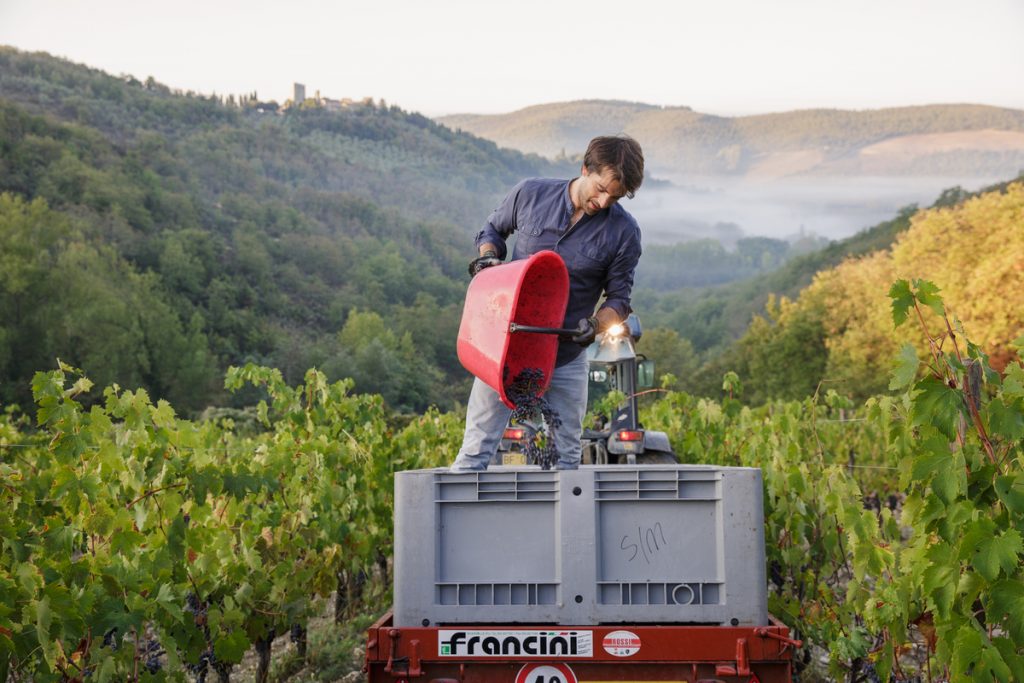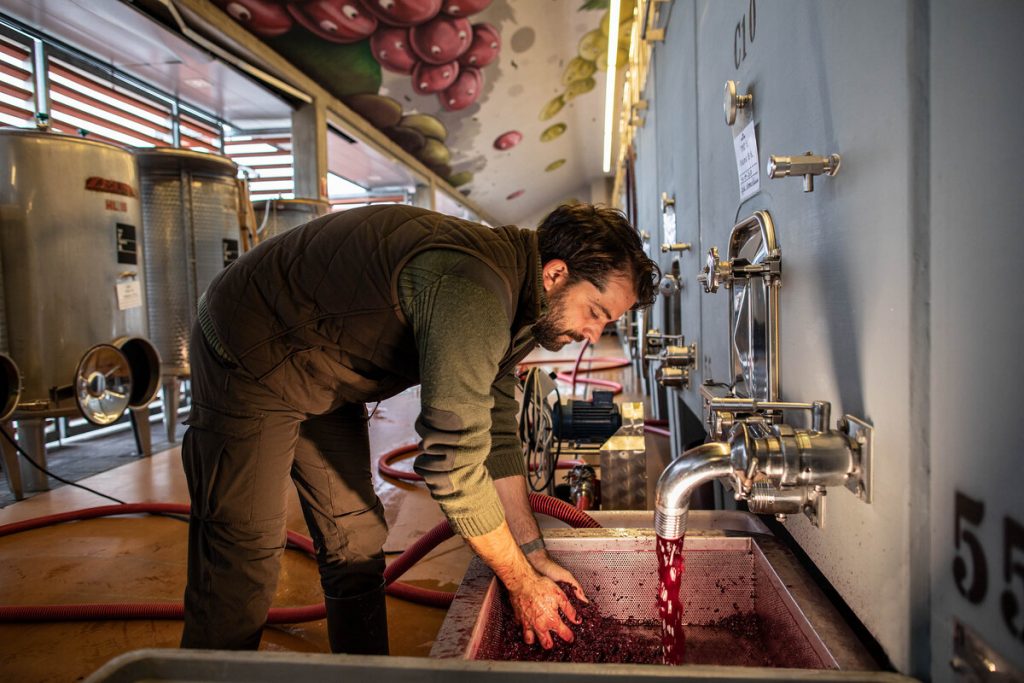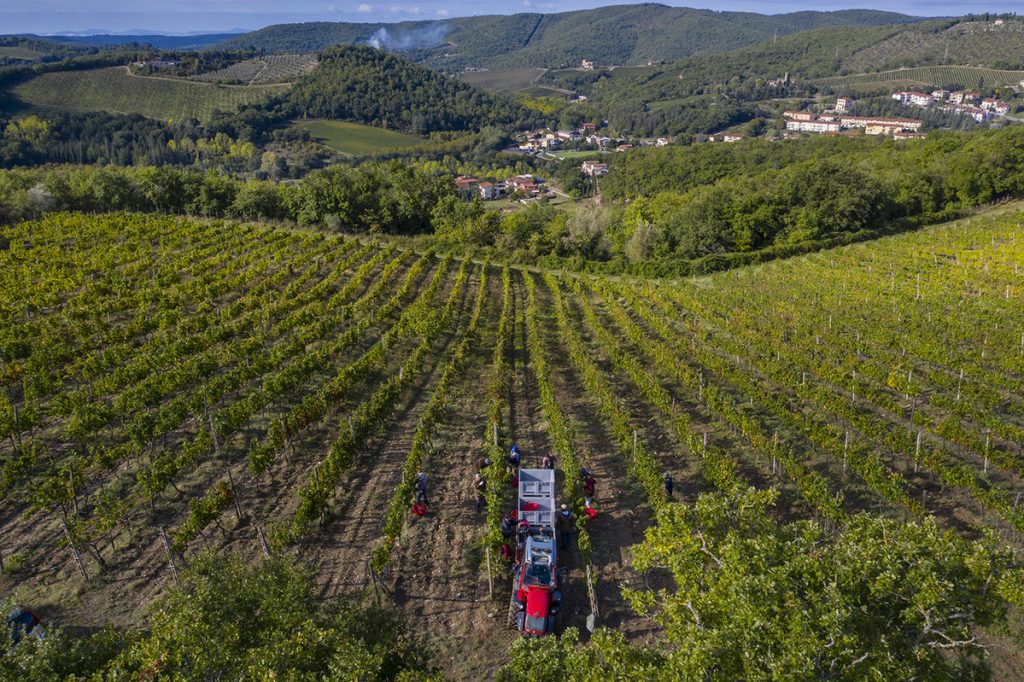

Riecine, an estate in northern Gaiole, turned in its best performance ever in our recent Tuscan tasting panels, leading all other wines in the Chianti Classico Annata, Riserva and Gran Selezione categories.
Riecine has had three owners and three winemakers in its fifty-year history. When current owner Lana Frank bought the estate at the end of 2011, Sean O’Callaghan had been the winemaker for two decades. Frank initiated a renovation and expansion of the winery, replacing stainless steel tanks with concrete and barriques with tonneaux. She also oversaw the replanting of some vineyards and purchased several new plots. Tuscan native Alessandro Campatelli, who had been working for Andrea Franchetti at Tenuta di Trinoro, joined Riecine’s team in 2015 as general manager and took over as winemaker when O’Callaghan departed a year later. The estate released its first Gran Selezione wine this year, from the 2019 vintage.
During a Zoom call this month, Campatelli discussed his winemaking philosophy and the decision to release this new wine.


What were some of the winemaking changes you instituted at Riecine?
When I came, I stopped using selected yeasts, but more important, I stopped crushing the grapes. Sean [O’Callaghan] used to crush with the feet; I stopped that. Franchetti, my mentor, never used to crush the grapes. He liked, a lot, the carbonic maceration. When you increase the cold maceration period, you have more extraction of fruit and flavors, and then you have a carbonic maceration in that period. So I tried this immediately in 2016. It was one of the biggest changes I made in the Riecine system.
One of the hallmarks of Riecine’s 2019 and 2020 Chianti Classico wines is their vibrance and freshness. What steps do you take to achieve this?
Climate change is becoming a problem for this. We have no trouble any more reaching ripeness, but, in the vineyard, we have to work to protect grapes from the sun, so we keep more vegetation. We have to fight to let the grapes enter the cellar at the lowest possible temperature. I cool down the grapes after harvest and never crush the same day, because when you pick and the grapes are 38 degrees Celsius, the fermentation can occur too fast. I want them to be no more than 22-24 degrees.
Also in 2017, I put a cooling system in some of the tanks. On the second day of fermentation, I completely separate the skins from the juice and cool down the must, which is easier when the juice is separated. After twelve hours, I pump the cooled juice back over the skins, and then continue fermentation for about 20 to 25 days. The goal is to preserve the aromas and freshness. This also allows us to increase the time of skin-to-juice contact, without using any sulfur, and still do a spontaneous fermentation. If I don’t do this, it’s over in ten days. I’m doing as much as I can to increase the period of maceration in the tanks.
2019 is the first vintage of your Gran Selezione Vigna Gittori. How did your team decide to release a Gran Selezione?
We didn’t embrace the Gran Selezione immediately [the category was officially approved in 2014], because in the beginning many producers approached it as a way to do another super-Tuscan with the Black Rooster on the label. I didn’t like this. Riecine was always a sangiovese specialist, more in the Burgundy style than Bordeaux. But the introduction of the UGA was an important step, and especially the decision to change the blend of Gran Selezione to a minimum of 90 percent sangiovese with ten percent of local varieties only. For me this is a revolutionary step, and we had worked hard to convince the consorzio and other producers to work only with local varieties. Also, in 2019 we became owner of Gittori vineyard, which is only 100 meters from where I sit now.


What is special about the Gittori vineyard?
We rented Gittori for more than 20 years, and when the previous owner from Florence passed away, we were allowed to buy the vineyard, which we did in July 2019. The vineyard was planted in 1974 and is about 2.7 hectares [6.67 acres], 500 meters [1,640 feet] above sea level with a southern exposure. The soil is very rocky, with big chunks of limestone and lots of iron, similar to some of our other vineyards, but Gittori has the most extreme version of these characteristics. It is hard to imagine how vines can survive. The soil gives sapidity and minerality, and a bloody or salty taste to the wine.
Gittori has three different plots that ripen at different times, and we keep them separate. When we purchased the vineyard I still wasn’t 100 percent sure we would make a Gran Selezione, but I made the first step as a usual Chianti Classico, fermented in concrete. At the end of 2019, I started to think about Gran Selezione, so I decided to make a separate aging process for a small part of the wine, in old tonneaux for 24 months plus six months bottle. I became more convinced as we went along.
Gran Selezione should be like a photograph of the terroir. If you close your eyes and taste the wine, you should immediately feel the terroir of Riecine. We are in the midst of forests, cultivated [many years ago] by monks from Abbazia di Coltibuono. They planted trees like fir, cypress and pine, and they used to sell the wood from this forest. Now it is wild, but all these trees release resins, and you can smell that from the terrace at Riecine. You could never mistake the Gittori wine as one from Radda. It is something else, it is from this place.
is the Italian wine editor at Wine & Spirits magazine.
This is a W&S web exclusive. Get access to all of our feature stories by signing up today.

















